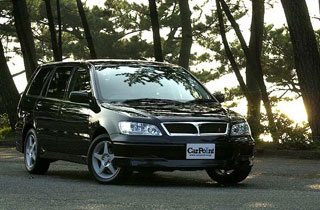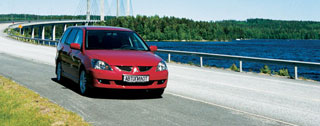Test drive Mitsubishi Lancer Evolution VIII 2003 - 2005 sedan
Legal evolution
What is Lancer Evolution VIII? Another step of the staircase that has no end? Yes and no. Mitsubishi not only improved the model, but also changed the global marketing policy on EVO.At a T-shaped cross, the right four and Pedal to Metal are giving way. The first, second, third under the whistle of the turbine. I wonder how firmly going towards the truck settled in our lane? As the cars rowed, my gaze rises to the level of the amazed physiognomy of the driver of the van and stumbles on the upper cut of the windshield of our Evo VIII large Keep Left!. My God, I completely forgot where we ... Deviations of the steering wheel left by 10 degrees, no more, is enough to avoid contact: the steering is acute, with pepper. We are in England, more precisely in Wales. It was here, in one of the main rally capitals of the world, that the European presentation of the eighth evolution of the legendary Mitsubishi Lancer took place.
It is not difficult to distinguish the novelty: the front line now corresponds to a modern corporate style. With a general loss in aggressiveness, compared to the previous version, aerodynamics improved both in the aspect of the magnitude and distribution of the lifting forces and in the aspect of the frontal resistance. The rear spoilers are now two to choose from the number of configuration options: Elegance and Sport. Both spoilers are unregulated. Tall, in the Sport version, is made of a real carbonate. Yes, this is not a decorative film at all. The pleasure is expensive, but Mitsubishi engineers and marketers are sure that the use of such materials is justified in road cars.
The first thing that attracts attention at the beginning of movement is unexpectedly for Lancer Evolution, a convenient and humane clutch pedal. In this machine, you can completely move around the city, stand in traffic jams and not experience discomfort from the work of sports transmission. At the same time, with active acceleration and rapid gear switch, the clutch grasps briefly and reliably: even with relatively long driving sessions in the combat mode of suspicious odors or other signs of overvoltage, no overvoltage. Bravo. In the lower part of the working range of engine speeds, before the active inclusion of the turbine in the operation, we are dealing with an ordinary city car, but it is worth allowing the motor to whistle slightly how a mask of political correctness remains far beyond the stern.
From two to three and a half thousand turns per minute, the first small pickup occurs, giving way to the turban, in which the tachometer arrow instantly jumps to the mark 7. The limiter is triggered in the region of eight thousand and not too hard, so as not to disrupt the car from the turn of the turn, If the pilot has gazed with switching. There is already especially nothing to look for close to cutting off, but to ensure gear shifts without jerking and maintaining the rate of speed set, it still makes sense to twist the engine up to more than seven thousand: this will constantly keep it in the turbosone.
The engine itself, like its settings, has not undergone significant changes compared to EVO VII, which can not be said about the all -wheel drive system. The active rear rear differential of a conical type is replaced by the Super Ayc planetary node. Super consists in the greater performance of differential blocking: the previous mechanism could not cope with the huge difference in the size of the torque on the inner and outer rear wheels that arise in an active turn on dry asphalt. The principle of operation of the all -wheel drive system EVO VIII is considered on the insert. Speaking about the practical side of the matter, we note that now you can slightly put it on the gas even at the exit of the coolest studs a little earlier and more boldly: the car shoots like a sling, not suffering from an excessive tendency to drift the rear axle.
In addition to Super AYC in the all -wheel drive system, an increased friction differential on the front axle and the Lancer Evolution are already known for previous models of the ACD is already known for previous models. There is also the usual possibility of choosing the modes of asphalt, gravel, snow. Simplified in official press releases, it is stated that in fact, this choice means a change in the degree of locks from hard for asphalt to almost free to increase stability in snow mode. In fact, as it was possible to find out in private conversations with the developers of the machine, everything is much more complicated, and for the conscious management of EVO VIII, this information is important.
In asphalt mode, everything is aimed at the most efficient turn of the turn, that is, classic, with minimal slides. Electronics for controlling the degree of locks in their conclusions are guided not only by assessing the speed of rotation of the wheels, but also to analyze the linear and angular accelerations of the car body with the testimony of the G-sensors, sensors of the position of the steering shaft, pedals and manual brakes. The control system will hold ACD on the way to the turn for more efficient braking, dissolve at the entrance for better steering and is again blocked at the output for maximum use of wheels with the road during acceleration.
Thus, if you want to go through a turn by a fan, the car should decide that its driver simply lost his mind, since the angle of rotation of the front wheels and all other parameters are mixed in chaos, in terms of ideas about the perfect trajectory. But the EVO is initially a rally car, therefore, it should feel good in deep slipping. Of course, the designers took into account these requirements. So, in the modes for the two remaining coatings, electronics will favorably react to such liberties and will not try to instantly work out with differentials each of your impulses by the steering wheel while you enjoy a gravel -style ride.
Nevertheless, the main advantages of the eighth evolution (and it is stated, without false modesty, a 10 percent decrease in the radius of the maximum turn compared to EVO VII) are manifested precisely when driving with a minimum of sliding, and therefore, with maximum disclosure of the abilities of active differentials.
To comprehend the algorithms of the action of the car systems and, more difficult, translate this knowledge into skills to the level of reflexes, you will need to spend a lot of time in training and reconsider your driving style (racers are also talked about these differences). And until then it will fairly seem that the fantastic capabilities of the machine were far from completely used.
However, all this is only a technique. The pleasure of the management of Evo VIII is difficult to express in words. Here you can revel in every moment: powerful accelerations under the whistle of a turbine, the precision work of the KP lever, an instant response of the car to the slightest movement of the steering wheel, which makes only two turns from the stop to the stop, the way that evolution digs into the asphalt on braking and how easy it is to control the slowdown
Tough speed restrictions have on English highways. The serpentines ended, and EVO, among other machines, rolls on even asphalt. Paying attention to the salon, we note: the differences from the usual Lancer are a little sports seats with only two adjustments, finishing from more expensive materials. Evolution is still designed as an honest sports car extremely simple and functional. There are no pseudocarbon inserts and perforated pedals, they are the most ordinary. The knob of the KP handle does not sparkle with polished metal, but is sheathed with the skin, which makes the gear shift as convenient as possible.
The radical difference between EVO VIII and all predecessors is as follows: it is a certified car around the world that can be purchased at the ordinary Mitsubishi official dealer in Europe, America or Russia. Moreover, the same factory warranty is now applied to this model as any other.
The effect of the torque transmission to the outer wheel is achieved in case of active rotation, when the outer wheel is loaded stronger than the internal due to the action of centrifugal forces. In such a situation, rigid locking ensures the equality of the angular velocities of the inner and external wheels with a significant difference in the moments on them. On the contrary, the work of a free differential would ensure the equality of moments with a difference in angular velocities. At the same time, the moment comes to the outer wheel, equal to the attached to the inside, very small due to unloading the wheel. Accordingly, along with the ability of tires to perceive the side load on the apex, acceleration at the exit from the turn will be ineffective.
Traditional types of blocking, that is, a differential of increased friction and viskobing, have a number of disadvantages. The first method leads to the fact that the blocking is not rigid enough during the opening of the gas, at the same time not free enough when it is necessary to ensure the absence of a slip of the wheels during rollering in the arc, which only provides a free differential. In the second case, the lock is closed with the difference in the angular speeds of the wheels. Visclaling will cope well with ensuring the acceleration at the output, but also in a steep turn with a significant difference in the ratio of the lengths of the inner and outer wheels, it will also block and cause slippage, thereby reducing the level of maximum lateral forces on the tires.
The EVO VIII all -wheel drive system allows you to reveal the potential of both a rigidly blocked differential and free exactly when necessary. However, hence the more complex car drive equipment. You need to learn how to anticipate the moment when he switches his modes in order to use these abilities completely.
Technical characteristics of Mitsubishi Lancer Evo VIII
Sedan body
Equipped mass, kg 1470
Full mass, kg 1885
Dimensions (length/width/height), mm 4490/1770/1450
Base, mm 2625
Maximum speed, km/h 245
Acceleration time to 100 km/h, from 6.1
Engine:
-type of gasoline, in-line, 4-cylinder, 16-valve., DOHC, with a turbocharger and intercooler
- working volume, cm3 1997
- Power, L.S. at MIN-1 265/6500
- torque, N.M at min-1 355/3500
Mechanical transmission, 5-speed
Tire size 235/45R17
Wheel suspension (front/rear) mcpherson/multi -link
Disc, ventilated brakes
The steering gear-rake
Price, $:
- Sport 43900
- Elegance 44900
Text: Dmitry Sokolov
Source: Magazine 5 wheel [04/2004]








